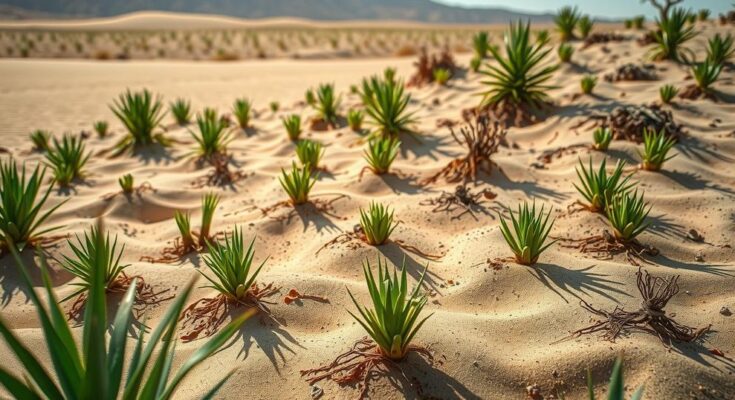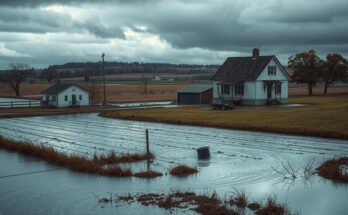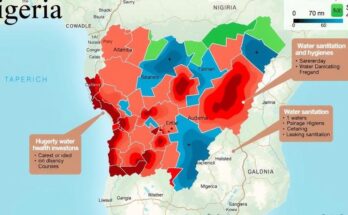Research conducted in Argentina’s Neuquén province assesses the effectiveness of assisted natural regeneration (ANR) required by law on decommissioned oil drilling sites. The findings reveal lower plant density and diversity compared to undisturbed areas, yet an unexpected presence of certain plant species. Experts advocate for further examination of soil microbiomes and methods to enhance recovery in desert ecosystems.
In Neuquén province, Argentina, local regulations mandate that oil companies create furrows on decommissioned drilling sites to aid plant growth, a method known as assisted natural regeneration (ANR). Recent research, however, has revealed that this practice’s effectiveness had not been previously evaluated until now, providing critical insights into restoration efforts in desert ecosystems.
A 2024 study by researchers from the National University of Comahue compared sixteen ANR sites with undisturbed desert areas. Over a five-year period, the results indicated that the sites restored using ANR exhibited significantly lower plant density, diversity, and coverage. Nonetheless, the study found a surprising presence of about 40% of species typical to undisturbed areas, revealing some unexpected successes among certain plant species.
The challenging conditions in the Monte Desert exacerbate plant survival; severe temperature fluctuations, scant rainfall, and nutrient-deficient soil hinder growth. Historical and ongoing oil extraction activities have devastated natural habitats, creating locations where plant life has largely vanished. When these drilling sites cease operations, the lost vegetation struggles to repopulate the impacted areas.
Florencia del Mar González, the study’s lead investigator, highlighted that the initial analysis through satellite imagery indicated minimal regrowth. Yet, during field investigations, her team encountered unexpected ecological responses, prompting further inquiry into the restoration techniques applied. This research represents a pivotal moment in understanding the implications of regulations on ecological recovery efforts.
ANR encompasses various passive restoration approaches aimed at improving natural plant growth conditions, contrasting with more labor-intensive, costly methods such as reseeding. Since 1999, Neuquén has mandated ANR practices on abandoned oil sites, which entail creating plowed furrows to facilitate water collection and create microhabitats for germinating plants.
Despite its implementation, the effectiveness of ANR in the Monte Desert remained untested until González’s systematic evaluation under her doctoral thesis. Comparing soil samples and vegetation at both degraded and healthy reference sites, the study cataloged a total of 15 plant species in the restored areas, notably some classified as “climax” species, which typically signify ecological stability. L. divaricata, recognized as a beneficial “nurse” plant, facilitates moisture retention and supports seedling growth.
However, the study revealed that plant coverage in ANR sites was still dramatically lower than in undisturbed areas—12.5 times less—while species diversity was only 16.6% of that observed in reference sites. James Aronson, a notable senior scientist in desert ecosystem restoration, emphasized the necessity of further research into soil microbiomes, as these underground communities are vital for plant resilience and growth.
Aronson stated, “If you want to do arid land or dryland restoration, you have to pay a lot of attention to what’s in the soil.” He highlighted the crucial relationship between desert flora and microbial life, particularly in nutrient-poor conditions where many plants rely on symbiotic interactions for survival.
In conjunction with ongoing studies, del Mar González aims to explore ways of introducing nurse plants to ANR-modified sites to bolster plant survival and growth. Furthermore, she suggests that current furrow standards might need adjustment for deeper excavation to enhance water retention and temperature moderation. This research could extend beyond the desert to provide strategies for improvement in degraded environments worldwide.
Del Mar González remarked, “At the end of the day, an oil esplanade is a cleared area without vegetation cover,” asserting that similar ecological recovery approaches can be adopted in various human-altered landscapes. These findings underscore the need for more comprehensive restoration methodologies addressing the unique challenges faced by arid ecosystems as crises like climate change escalate.
This research sheds light on the mixed effectiveness of assisted natural regeneration in the harsh environment of the Monte Desert, revealing both challenges and unexpected successes in plant species recovery. While the implementation of ANR has not fully restored plant density and diversity, it presents a foundational framework for future restoration efforts. Ongoing studies highlight the importance of integrating soil microbiome health and exploring more active restoration strategies to support the resilience of arid ecosystems, ultimately contributing to a broader understanding of ecological restoration.
Original Source: news.mongabay.com




